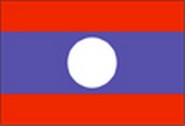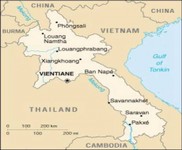Main menu:
Laos
Introduction |
||
Flag: |
|
|
Card: |
||
Background: |
In 1975 the communist Pathet Lao took control of the government, ending a six-century-old monarchy. Initial closer ties to Vietnam and socialization were replaced with a gradual return to private enterprise, an easing of foreign investment laws, and the admission into ASEAN in 1997. |
|
Geography |
||
Location: |
Southeastern Asia, northeast of Thailand, west of Vietnam |
|
Coordinates: |
18° 00' N, 105° 00' E |
|
Map references: |
Southeast Asia |
|
Area: |
total: 236,800 sq km |
|
Landesgrenzen: |
Gesamtmenge: 5.083 Kilometer |
|
Land boundaries: |
total: 5,083 km |
|
Border countries: |
Burma 235 km, Cambodia 541 km, China 423 km, Thailand 1,754 km, Vietnam 2,130 km |
|
Coastline: |
0 km (landlocked) |
|
Maritime claims: |
none (landlocked) |
|
Climate: |
tropical monsoon; rainy season (May to November); dry season (December to April) |
|
Terrain: |
mostly rugged mountains; some plains and plateaus |
|
Elevation extremes: |
lowest point: Mekong River 70 m |
|
Geography - note: |
Landlocked |
|
People |
||
Population: |
5.635.967 (Juliy 2001 est.) |
|
Nationality: |
noun: Lao(s) or Laotian(s) |
|
Ethnic groups: |
Lao Loum (lowland) 68%, Lao Theung (upland) 22%, Lao Soung (highland) including the Hmong ("Meo") and the Yao (Mien) 9%, ethnic Vietnamese/Chinese 1% |
|
Religions: |
Buddhist 60%, animist and other 40% |
|
Languages: |
Lao (official), French, English, and various ethnic languages |
|
Government |
||
Country name: |
conventional long form: Lao People's Democratic Republic |
|
Government type: |
Communist state |
|
Capital: |
Vientiane |
|
Independence: |
19 July 1949 (from France) |
|
Flag description: |
three horizontal bands of red (top), blue (double width), and red with a large white disk centered in the blue band |
|
Economy |
||
Economy - overview: |
The government of Laos - one of the few remaining official communist states - began decentralizing control and encouraging private enterprise in 1986. The results, starting from an extremely low base, were striking - growth averaged 7% during 1988-97. Reform efforts subsequently slowed, and GDP growth dropped an average of 3 percentage points. Because Laos depends heavily on its trade with Thailand, it was damaged by the regional financial crisis beginning in 1997. Government mismanagement deepened the crisis, and from June 1997 to June 1999 the Lao kip lost 87% of its value. Laos' foreign exchange problems peaked in September 1999 when the kip fell from 3,500 kip to the dollar to 9,000 kip to the dollar in a matter of weeks. Now that the currency has stabilized, however, the government seems content to let the current situation persist, despite limited government revenue and foreign exchange reserves. A landlocked country with a primitive infrastructure, Laos has no railroads, a rudimentary road system, and limited external and internal telecommunications. Electricity is available in only a few urban areas. Subsistence agriculture accounts for half of GDP and provides 80% of total employment. For the foreseeable future the economy will continue to depend on aid from the IMF and other international sources; Japan is currently the largest bilateral aid donor; aid from the former USSR/Eastern Europe has been cut sharply. |
|
Agriculture - products: |
sweet potatoes, vegetables, corn, coffee, sugarcane, tobacco, cotton; tea, peanuts, rice; water buffalo, pigs, cattle, poultry |
|
Currency: |
Kip (LAK) |
|
Currency code: |
LAK |
|
Transportation |
||
Railways: |
0 km |
|
Highways: |
total: 14,000 km |
|
Waterways: |
4,587 km approximately |
|
Ports and harbors: |
None |
|
Coffee |
||
Growing-areas: |
alongside the border of Cambodia and Vietnam |
|
Qualities: |
mainly Robusta unwashed |
|
Altitude: |
abt. 1000 meter |
|
Harvest: |
December - February |
|
Shippingperiod: |
January - May/June |
|
Port of Export: |
via Bangkok |
|
Shipments: |
In container in bags (300 of abt 60,- kos net) |
|
Production: |
not announced in ICO statistics |
|
Export figures: |
not announced in ICO statistics |
|
Special remarks: |
belongs to the "underdeveloped countries" |
|












